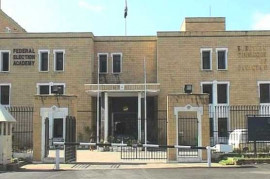
Today’s polls will rewrite this overarching trend. It is the first time a democratically-elected government is conducting LG polls in the province.
The form of public administration is seen as the brainchild of military dictators in Pakistan, who utilised the system to exert control and gain legitimacy at the grass-root level.
Iron fist
The first to open the military coup floodgates, Field Marshal Ayub Khan, was also ironically the first to introduce the four-tier Basic Democracies system. His Basic Democracy Order 1958 was fundamentally an attempt to put together an electoral college to validate his seizure of power at the helm of the government.
Following Ayub’s departure, the infant Pakistan Peoples Party performed considerably well in the 1970 general elections across West Pakistan. After the fall of Dhaka, the party set out to draft the country’s first comprehensive Constitution.
Article 32 of the newly-passed law of the land had stated, “The State shall encourage local government institutions composed of elected representatives of the areas concerned and in such institutions special representation will be given to peasants, workers and women.” Yet again this was implemented by the dictator who had overthrown the Bhutto administration.
Following the coup, General Ziaul Haq enforced his very own three tier non-party system in the country and held LG elections thrice during his tenure – 1979, 1983 and 1987. For another 12 years the system remained on the backburner.
In 2000, former dictator General (retd) Pervez Musharraf crafted yet another LG system. City district governments were introduced and nazims took charge of the lowest tier of the state. Musharraf ensured the system was reloaded twice; polls were held in 2002 and 2005.
The ten years since have seen some of the most significant political developments in the country. For better or worse, LG polls were still not on the agenda. It was only in 2014 that the Supreme Court’s ruling forced K-P government to go ahead and rewrite its history.
Legislation
The Awami National Party-led government (2008-2013) did take baby steps and managed to pass the K-P LG Act 2012 on May 8, 2012. It was an amalgam of reforms introduced by both Zia and Musharraf. It enforced a more centralised approach and reverted to nomenclature from Zia’s laws.
After coming into power, the Pakistan Tehreek-e-Insaf government introduced its own LG legislation and passed an act on October 31, 2013. The party set up 3,500 village and neighbourhood councils in place of the 950 union councils and wards of the province.
The law envisages a city district government and town municipal administrations for Peshawar and district governments and tehsil administrations for other districts.
The nazims and naib nazims have been brought back in business. Village and neighbourhood council set-ups will be non-party based and a winner-take-all system is in place for the general councillor securing the highest number of votes. District and tehsil councils’ elected members (party-based) will decide their nazims and naib nazims.
Published in The Express Tribune, May 30th, 2015.



































COMMENTS
Comments are moderated and generally will be posted if they are on-topic and not abusive.
For more information, please see our Comments FAQ